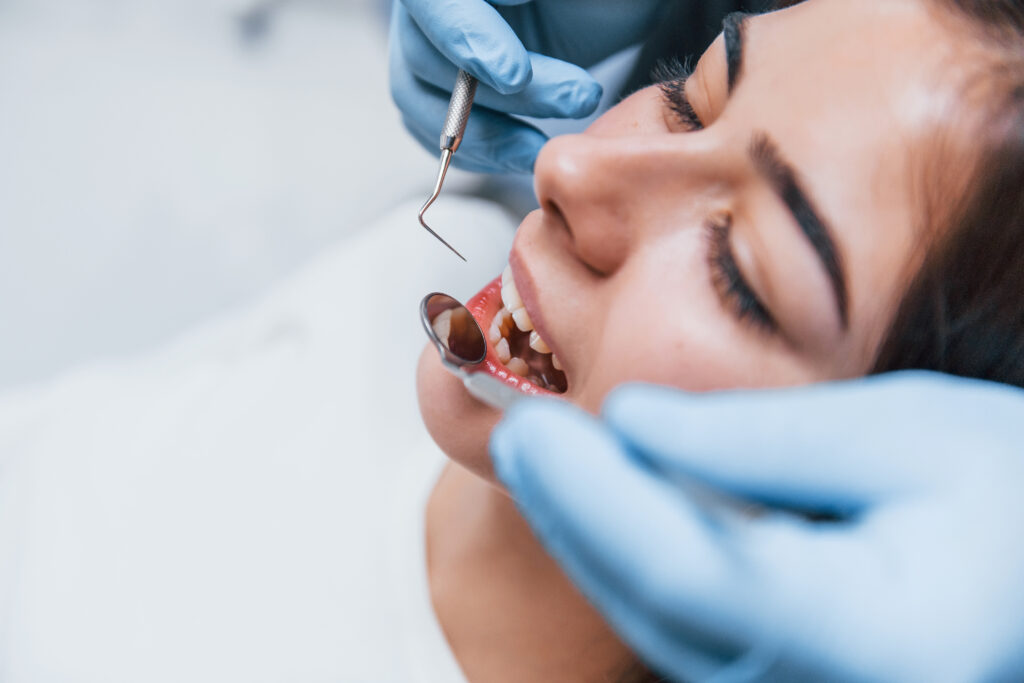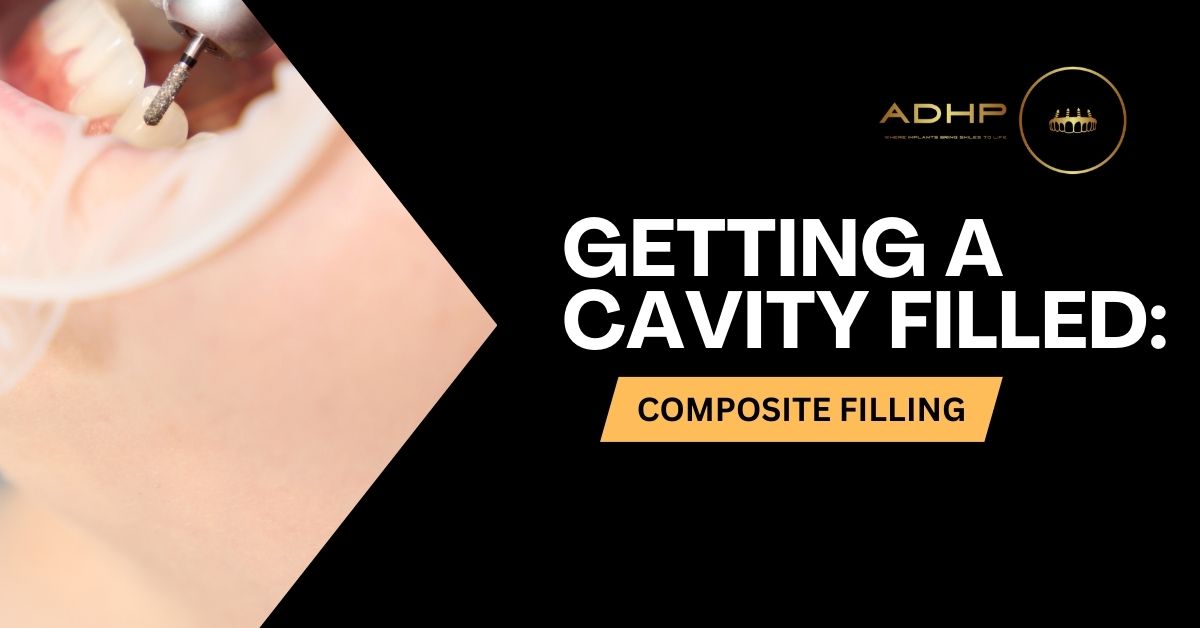Main Takeaways
-
Composite fillings are tooth-colored and made from a blend of plastic and glass, offering a natural look and strong bond to your tooth.
-
They are a popular alternative to amalgam (silver) fillings because they preserve more of the natural tooth, bond directly, and contain no metal or mercury.
-
The procedure involves removing decay, applying the composite in layers, and hardening it with a special light for a durable finish.
-
With proper care, composite fillings typically last 5–10 years, depending on factors like location, oral hygiene, and chewing habits.
-
Benefits include aesthetic appeal, conservative treatment, versatility, and less sensitivity to temperature changes compared to metal fillings.
-
Drawbacks may include higher cost, longer placement time, potential staining, and slightly less durability in large, high-pressure fillings.
-
Regular dental checkups, good oral hygiene, and avoiding hard foods help extend the life of your composite filling.
-
ADHP – Torrance offers expert dental care and personalized guidance on choosing the right filling for your smile and needs.
Nobody likes getting a cavity. That little hole in your tooth can be annoying, sometimes painful, and definitely something you want to fix. When you visit the dentist to get a cavity repaired, one of the most common solutions they offer is a composite filling. These tooth-colored fillings are popular for many reasons, but what exactly are they, and what should you know about them? Let’s talk about how these fillings work to fix your teeth and keep your smile looking great.
What Exactly is a Composite Filling?
When a dentist talks about a composite filling, they’re talking about a special kind of tooth repair that blends right in with your natural teeth. Unlike the old silver fillings (called amalgam fillings), composite fillings are made from a mix of plastic and fine glass particles. This mix can be colored to match the exact shade of your tooth, making it almost invisible when you smile.
Think of it like this: when you have a cavity, it’s a hole caused by decay. The dentist first cleans out all the decayed (bad) part of your tooth. Then, they fill that space with the composite material. This material is soft at first, like a thick paste. The dentist shapes it to fit perfectly into the hole and match the natural curves of your tooth. Once it’s in place, they shine a special blue light on it. This light makes the composite material harden very quickly, becoming strong and durable.
Because of its color-matching ability and the way it bonds to your tooth, a composite filling is a popular choice for fixing cavities, especially on your front teeth where they show, or even on back teeth where you want a natural look.
Why Dentists Use Composite Fillings: The Big Benefits
The reason so many dentists and patients choose a composite filling comes down to several important advantages. These fillings offer more than just fixing a hole; they help keep your smile looking its best.
- They Blend In: This is probably the biggest reason people love composite fillings. Since they can be matched to the exact color of your natural teeth, a composite filling is nearly invisible. You can laugh, talk, and smile wide without worrying about dark spots showing in your mouth. This is a huge plus, especially for cavities on front teeth or any part of your smile that people see.
- They Save More Tooth: With old silver fillings, dentists sometimes had to remove more healthy tooth material just to make sure the filling would stay in place. A composite filling actually bonds directly to the tooth structure. This means the dentist only needs to remove the decayed part of the tooth, leaving more of your healthy tooth untouched. Keeping more of your natural tooth is always better for the tooth’s long-term strength.
- They Bond to Your Tooth: The way composite material sticks directly to the tooth makes the tooth stronger. It helps support the remaining tooth structure and protects it from breaking. This bond also seals the tooth better, helping to keep out bacteria that could cause new decay under the filling.
- No Metal, No Mercury: Some people worry about the mercury content in old silver (amalgam) fillings. While dental organizations say amalgam fillings are safe, many people prefer a metal-free option. A composite filling offers this, as it contains no metal. This also means you don’t have to worry about the filling expanding and contracting as much with temperature changes, which could sometimes lead to cracks in your tooth with old metal fillings.
- Versatile Use: Besides filling cavities, composite material can also be used for other dental fixes. Dentists can use it to repair chipped or broken teeth, to fill in small gaps between teeth, or even to change the shape of teeth. This makes a composite filling a very flexible tool for improving smiles.
These benefits make a composite filling a top choice for modern dental care, helping you keep both your oral health and your smile looking good.
The Process: Getting a Composite Filling
Getting a composite filling is a common and straightforward procedure that most people go through without much fuss. Here’s a step-by-step look at what happens during your dental visit:
- Numbing the Area: First, your dentist will usually numb the area around the tooth that needs work. They’ll use a local anesthetic, which is a special medicine that makes your tooth and gums feel sleepy, so you won’t feel any pain during the procedure. You might feel a small pinch when the shot goes in, but then the area will quickly go numb.
- Removing Decay: Once the area is numb, the dentist will carefully use a drill or other tools to remove all the decayed or damaged part of your tooth. They need to make sure every bit of the cavity is gone before they put in the new filling.
- Preparing the Tooth: After cleaning out the decay, the dentist will prepare the tooth surface. They might use a special gel or liquid to make the tooth’s surface slightly rough. This helps the composite material stick better, creating a strong bond.
- Applying the Composite Material: The dentist will choose a shade of composite material that perfectly matches your natural tooth color. They’ll then apply the composite in small layers into the cleaned-out cavity. Since it starts as a soft, moldable paste, they can shape it precisely to fit the hole and rebuild the natural shape of your tooth.
- Hardening with Light: With each layer of composite, the dentist will shine a special blue light (called a curing light) on the filling. This light makes the composite material harden very quickly, usually in just a few seconds. This step is repeated for each layer until the cavity is completely filled.
- Shaping and Polishing: Once the entire composite filling is hard, the dentist will carefully shape and trim it so it fits perfectly with your bite and feels natural. They’ll ask you to bite down a few times to make sure your teeth come together comfortably. Finally, they’ll polish the filling so it’s smooth and shiny, just like your natural tooth surface.
The whole process usually takes about an hour, but it can vary depending on the size and location of the cavity. Once it’s done, you’ll have a strong, natural-looking fix for your tooth.

Living with Your Composite Filling: Care and Maintenance
Once you have a composite filling, you might wonder how to take care of it and what to expect. Good news: taking care of a composite filling is pretty much the same as taking care of your natural teeth!
- Regular Brushing and Flossing: Keep up your excellent oral hygiene habits. Brush your teeth at least twice a day with fluoride toothpaste and floss daily. This helps prevent new cavities from forming around your filling and keeps your whole mouth healthy.
- Regular Dental Check-ups: Don’t skip your regular dentist appointments. Your dentist will check your fillings to make sure they’re in good shape. They’ll also clean your teeth and look for any new issues.
- Watch What You Chew: While composite fillings are strong, they aren’t quite as tough as your natural tooth enamel. Try to avoid chewing on extremely hard things like ice, hard candies, or popcorn kernels directly on the filled tooth, especially shortly after the filling. This helps prevent chipping or breaking the filling.
- Stain Awareness: Composite materials can sometimes pick up stains from coffee, tea, red wine, and tobacco over time, just like your natural teeth. Brushing regularly helps, but if you notice staining, talk to your dentist. Whitening products usually don’t work on fillings, so the filling might need to be replaced if it gets too discolored.
- Sensitivity After Placement: It’s normal to feel some slight sensitivity in the filled tooth for a few days after getting a composite filling, especially to hot or cold. This usually goes away on its own. If the sensitivity is severe, lasts a long time, or gets worse, call your dentist.
- Feeling Your Bite: If your bite feels “off” or uncomfortable after the numbing wears off, call your dentist. They can adjust the filling so it feels perfect.
With good care, a composite filling can last for many years, helping you maintain a healthy and attractive smile.
How Long Does a Composite Filling Last?
When you get a composite filling, you probably want to know how long it will last. While there’s no exact answer, a composite filling generally lasts a good number of years.
On average, a composite filling can last anywhere from 5 to 10 years, or even longer. However, how long it actually lasts depends on several things:
- Where it is in your mouth: Fillings on your front teeth, which don’t do as much heavy chewing, often last longer than fillings on back molars that take a lot of pressure from chewing.
- The size of the filling: Smaller fillings usually last longer than very large ones, which replace more tooth structure and might be under more stress.
- Your chewing habits: If you grind or clench your teeth (a habit called bruxism), this extra pressure can wear down fillings faster. If you have this habit, your dentist might suggest a night guard to protect your teeth and fillings.
- Your oral hygiene: Good daily brushing and flossing, along with regular dental check-ups, help keep your filling and the surrounding tooth healthy, which helps the filling last longer. Preventing new decay is key.
- The dentist’s skill: A well-placed and carefully bonded composite filling by a skilled dentist will generally last longer.
- Diet: Chewing on extremely hard foods frequently can put extra stress on fillings.
Over time, any filling can wear down, chip, crack, or even develop new decay around its edges. That’s why those regular dental check-ups are so important. Your dentist will monitor your fillings and let you know if one needs to be repaired or replaced. While a composite filling offers great durability and looks, it’s not a permanent solution, and eventually, it might need attention.
Composite vs. Amalgam (Silver) Fillings: A Quick Comparison
When you need a cavity filled, your dentist might mention different types of fillings. You’ve heard about composite filling, but what about the older silver ones? Here’s a quick look at how they compare.
Composite Fillings (Tooth-Colored):
- Appearance: Matches your natural tooth color, making them nearly invisible. This is their biggest advantage, especially for front teeth.
- Bonding: They bond directly to the tooth structure, which means less healthy tooth needs to be removed. This bonding can also strengthen the tooth.
- Mercury: No mercury is used in composite materials.
- Cost: Generally more expensive than amalgam fillings.
- Placement Time: Can take a little longer to place because they are applied in layers and hardened with a light.
- Durability: Very durable, especially for small to medium-sized fillings, but might not be as long-lasting as amalgam in very large, high-pressure areas over many years. Can sometimes stain over time.
Amalgam Fillings (Silver):
- Appearance: Silver in color, which makes them very noticeable. Not preferred for teeth that show when you smile.
- Placement: Don’t bond to the tooth. The dentist has to shape the cavity to “hold” the filling in place, which sometimes means removing more healthy tooth.
- Mercury: Contain a mix of metals, including about 50% mercury. Dental organizations say they are safe, but some people prefer to avoid mercury.
- Cost: Generally less expensive.
- Placement Time: Can be quicker to place than composite fillings.
- Durability: Very strong and durable, especially for large fillings in back teeth that handle a lot of chewing pressure. They are very resistant to wear.
Both types of fillings are effective at fixing cavities. Your dentist will discuss the pros and cons of each based on your specific cavity, its location, your budget, and your personal preferences. For many, the natural look and bonding ability make a composite filling the preferred choice for modern dental care.
Potential Disadvantages of Composite Fillings
While a composite filling offers many advantages, it’s fair to know about some of its downsides too. Understanding these can help you and your dentist decide if it’s the right choice for your cavity.
- Cost: Composite fillings are generally more expensive than amalgam (silver) fillings. This is because the materials themselves cost more, and the procedure to place them takes a bit more time and skill.
- Placement Time: Because composite material is applied in layers and each layer is hardened with a special light, the process of getting a composite filling can take a little longer than getting an amalgam filling. This means you might spend a bit more time in the dental chair.
- Durability for Very Large Fillings: While very durable for small to medium-sized cavities, for extremely large cavities on back teeth that take a lot of chewing force, some dentists might still lean towards amalgam for its very long-term toughness, though composite materials are constantly improving.
- Sensitivity After Placement: As we talked about earlier, it’s common to experience some temporary sensitivity to hot or cold for a few days after getting a composite filling. This usually goes away, but it can be uncomfortable for a short time.
- Staining: Over time, composite fillings can pick up stains from coffee, tea, red wine, and other darkly colored foods, just like natural teeth. This means they might dull or change color, while your natural teeth can be whitened around them. If they get too stained, they might need to be replaced to maintain a uniform smile.
- Skill Sensitivity: Placing a composite filling correctly requires a very dry environment and precise technique. If moisture gets in during the bonding process, or if the layering isn’t done perfectly, the filling might not last as long or could fail prematurely.
These points are things your dentist will consider and discuss with you to ensure you get the best filling for your specific needs. The goal is always to provide a lasting and effective solution for your cavity.

Keeping Your Smile Strong and Bright With ADHP Torrance
Dealing with a cavity is never fun, but thankfully, modern dentistry offers great solutions like the composite filling. These tooth-colored fillings help fix the problem while keeping your smile looking natural and beautiful. They bond well to your tooth, allowing your dentist to save more of your healthy tooth structure, and they don’t contain any metal.
While it’s important to know about their benefits and potential downsides like cost or temporary sensitivity, for many people, a composite filling is a fantastic choice for repairing cavities. Good daily brushing, flossing, and regular dental check-ups are key to making any filling last and keeping your whole mouth healthy.
If you think you might have a cavity or want to learn more about a composite filling and what’s best for your smile, don’t hesitate to reach out. For expert dental care in Torrance and personalized advice on keeping your teeth strong and healthy, contact ADHP – Torrance today. Their team is ready to help you maintain a confident and healthy smile.


